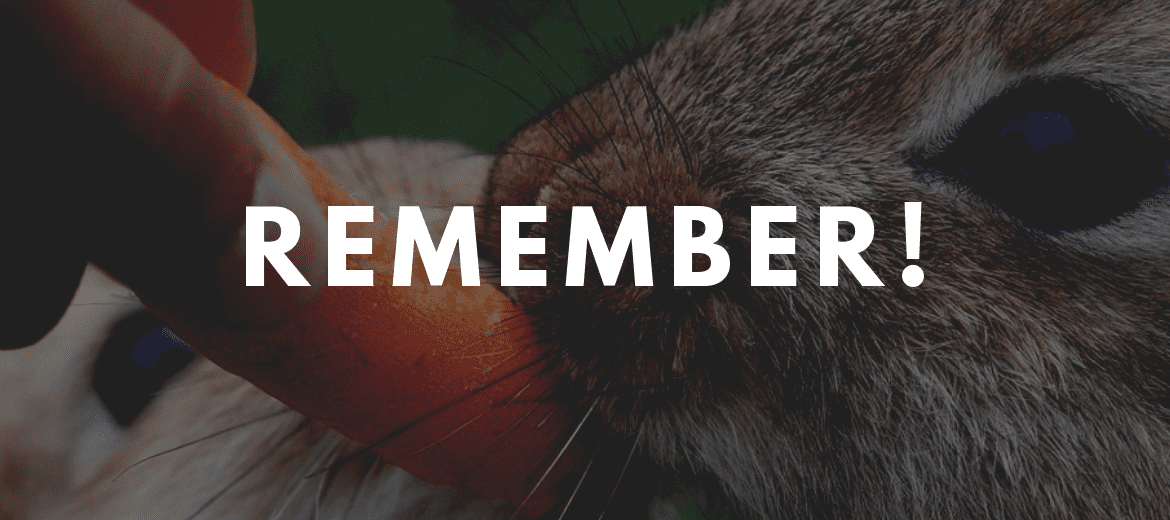Why It’s SO Important
A rabbit’s nutrition is probably the most important thing to understand and get right.
Rabbits have a delicate and complicated digestive system that needs to be kept in balance or they are likely to become ill and stop eating. This can then set them on the path to an episode of GI Stasis.
GI Stasis: What It Is + Symptoms
When a rabbit develops GI Stasis, it basically means that their gut and digestive tract have stopped moving and are shutting down.
It is very painful for them, and they will often lie on their tummy and slightly hunched forward, grinding their teeth. Also, their ears will go cold, which is an indicator that their temperature has dropped.
GI Stasis is life-threatening if left untreated or if the rabbit doesn’t get to a vet quickly enough.
Gas
Gas symptoms are very similar, except that a rabbit will often hiccup at the same time, which moves the gas through the gut.
Hiccuping should only last a short period of time so if it doesn’t stop then, there is more going on in the gut.
Rabbits don’t vomit or belch like humans or other pets, so if something is upsetting the balance of their tummies or if they get gas, it has to work its way through and come out the other way.

My Personal Experience with These
My own rabbit Speedy had GI Stasis so in a week, we had to make several trips to the vets for medications and treatments to get his gut moving again. At it worst he even had diarrhea for about a day.
I stayed up with him in the kitchen after finding him covered in black muck and had to bath him to get it off…
Trust me, you don’t bathe rabbits unless something like this happens and well, Speedy had to be cleaned up 6 times in the night.
He was force-fed critical care food, mashed pumpkin, Fibreplex, and other medications just to keep him alive until he started to eat on his own again.
That was the worst week of my life where I really thought we would lose him.
He pulled through, but now both I and his dad watch him like a hawk so that we pick up on the signs that something is not right with his gut and start basic things like critical care food and fluids.
The main sign usually starts when he doesn’t eat his salad. We then try to tempt him with his favorite treats and if he turns his nose up at that, then we know to start fluids, critical care food, and baby gas drops.
That has saved us many trips to the vets and great expense.










So How Do We Keep a Rabbit’s Digestive Tract Happy and Healthy?
Well, for starters, by getting the diet right.
A rabbit’s basic diet should be 80% hay, 10% leafy greens and 10% Timothy Hay-based pellet food.
However, it is possible to reduce the pellet portion of their diet if they are overweight to just 5% or even 0%.
Let’s face it, a wild rabbit doesn’t eat pellet food.










Baby Rabbit Dietary Needs
A baby rabbit under 16 weeks old should have an alfalfa-rich diet. This is higher in calcium and calories, which they need to grow strong teeth and bones.
A bad diet at this stage (where they are lacking in calcium) can cause problems with the growth and formation of their teeth. This can then lead to teeth problems in adulthood.
Soon after the baby rabbit reaches 16 weeks, Alfalfa needs to be phased out and changed over to a Timothy hay-based diet.
By this stage, a rabbit has become a young adult and can quickly become overweight, so too much calcium is not good for them.
A rabbit can’t process excess Calcium so it has to be flushed out through their urinary tract and bladder.
Too much causes a white powdery sludge to build up in the bladder which can cause blockages, bladder stones, and urinary tract infections.










Timothy Hay and Meadow Hay
So Timothy grass-based hay is good for adult rabbits. Alternatively, you could opt for proper meadow hay.
Meadow hay is good because it contains wildflowers and herbs as well as a mix of lots of different grasses.
This helps your rabbit have a varied diet, which leads to a happy healthy tummy.










Another way to increase variety is through their salads, but that’s where things get tricky.
While some greens and vegetables are generally safe for a rabbit to eat, there are others that should only be eaten in small amounts because they are high in Oxalates.
In large amounts, Oxalates (or oxalic acid) can have a toxic effect that goes from causing itchy skin to actually affecting the liver.
The trouble is that some of the greens that contain Oxalates also come with beneficial substances which can help keep a healthy, balanced gut.

Things to Remember:
- The 1st thing to remember is that a little bit in moderation is OK, but too much is a bad thing.
- The 2nd thing to remember is that you have to introduce new foods slowly and in small amounts to make sure it doesn’t make their dung soft.
Now on to the bad stuff! Remember that things like bulbs and evergreens are bad for your rabbit. Many other plants are also poisonous for your rabbits.
So I shall try to offer a comprehensive list of what is safe for a rabbit to eat and what is not safe.










Healthy/Unhealthy Rabbit Food Lists

Safe Vegetables and Herbs from the Supermarket:
- Artichoke leaves
- Asparagus
- Beetroot leaves (only in small amounts – they contain Oxalates and can cause gas)
- Broccoli (including leaves and the purple ones – but in small amounts as they can cause gas)
- Brussel Sprouts (leaves and sprouts – in small amounts as they can cause gas)
- Cabbage (in small amounts as can cause gas and upset the tummy)
- Carrots and the green tops (the carrots – small pieces only and as a treat as they are high in sugar)
- Cauliflower (and the leaves)
- Celeriac
- Celery leaves
- Chicory
- Courgette (flowers included)
- Cucumber
- Curly Kale
- Fennel
- Green Beans
- Kohl Rabi
- Peas (including the leave and the pods)
- Peppers (Red, Green, and Yellow)
- Pumpkin
- Radish Tops (in small amounts as they can cause gas)
- Rocket (this is also known as Arugula)
- Romaine Lettuce (only the darker green leaves, NOT the stalk part, NOT Iceberg or any light-colored lettuce)
- Spinach (in small amounts and only occasionally – it contains Oxalates)
- Spring Greens
- Squash (e.g. Butternut)
- Swede
- Turnip (only in small amounts)
- Watercress










Fresh Herbs:
They work great in adding variety, but they have quite a strong taste. They need to be introduced in small amounts at first, but once a rabbit tries them, they usually love them.
- Basil
- Coriander (also known as Cilantro)
- Dill
- Mint (Peppermint)
- Oregano
- Rosemary
- Sage
- Thyme

Fruits:
Your list of rabbit food can include fresh fruits, but these should only be given as a treat.
This is because they are high in sugar, so you need to limit how much you give them as too much sugar is bad for their teeth and can make them gain weight.
!But remember to take out the pips and stones as they are poisonous to rabbits!
- Apple
- Apricot
- Banana (small quantity – it is high in Potassium)
- BlackBerries (and their leaves – they have great Astringent properties)
- Blueberries
- Cherries (not the stones or the plant – poisonous as they contain cyanide)
- Grapes
- Kiwi Fruit
- Mango
- Mellon
- Nectarines
- Papaya
- Peaches
- Pears
- Pineapple
- Plums
- Raspberries (and their leave – they have great Astringent properties)
- Strawberries (and their leaves)
- Tomatoes (NOT the leaves or the plant – these are poisonous)

Plants, Weeds, and Wildflowers
Many plants, weeds, and wildflowers are safe for our rabbits to eat.
But you will need to double-check what you have in your garden before letting your rabbit out for playtime, to make should they don’t stumble over something dangerous for them.
Still, you can rest assured that the following are great for you to forage for your rabbit:
- Apple (Branches and leaves)
- Borage
- Birch (Branches and leaves)
- Calendula
- Camomile
- Chickweed (has Astringent properties)
- Clover (Leaves and Flowers)
- Coltsfoot
- Comfrey
- Dandelions (these have diuretic properties and us humans can eat them in salads too)
- Honeysuckle (make them into little wreaths and let them dry – this makes for a great chew toy – make sure there are NO Berries on them)
- Hazel (Branches and leaves)
- Hawthorn (Family of trees)
- Lavender
- Mallow
- Nettles
- Nasturtium (Leaves and flowers)
- Roses (Leave and Flower petals)
- Shepherd’s purse
- Sow Thistle
- Plantain
- Willow (Branches and leaves)
- Yarrow

Things to NEVER Give to Your Rabbit
This next list is about poisonous plants and vegetables that should never be fed to rabbits.
Things like seeds and nuts shouldn’t be given to rabbits either as while they may not be poisonous, they can still upset the balance of their gut and cause gas.
Plants and Flowers:
All plants and flowers that are grown from bulbs such as:
- Daffodils
- Onions
- Lupins
- Gladioli
- Bluebells
- All Bulbs are toxic to rabbits (Chives, Wild Garlic included)
- Amaryllis
- Arum Lily (Cuckoo point)
- Bindweed
- Bracken
- Bryony
- Buttercup (Though small amounts found in dried hay are OK)
- Convolvulus (Bindweed)
- Deadly Nightshade (Belladonna)
- Delphinium (Larkspur)
- Elder
- Fools Parsley
- Foxglove
- Hellebores (Christmas Rose)
- Hemlock
- Henbane
- Lily of the Valley
- Lupin
- Laburnum
- Most Evergreens
- Oak leaves
- Poppies
- Potato tops
- Privet
- Ragwort
- Rhubarb leaves
- Scarlet runner toadflax
- Woody Nightshade
- Yew
Final Tips and Advice on Rabbit Food
There are many more plants that are poisonous to rabbits but basically, if you stick to what is on the safe list, you can be sure you will keep your rabbit happy and healthy.
And there are many more plants that are safe for them which you can check with other sources for extra information (e.g. the House Rabbit Society).










There is also a group on Facebook called Wild Nutrition & Foraging for pet rabbits (No Breeders) where you can join and upload photos of plants.
They will identify the plant for you and tell you if it is safe or not for your rabbit. It’s a great resource to use.
Just remember: if you are unsure then don’t give it to your rabbits until you have checked to make sure it is safe for them.










Suggested: You can read more of Rachel’s advice about how to welcome a rabbit into your home (and what to consider before doing so) and about how to prepare your house for a new pet rabbit!

Rachel is the Mum of Speedy, a male Himalayan Rex Rabbit who is over 7 years old. She started his blog to help people find out more about rabbits and other small house pets.
Anything from how to welcome them into your home to how to feed and hold them correctly, Rachel is the one to ask!